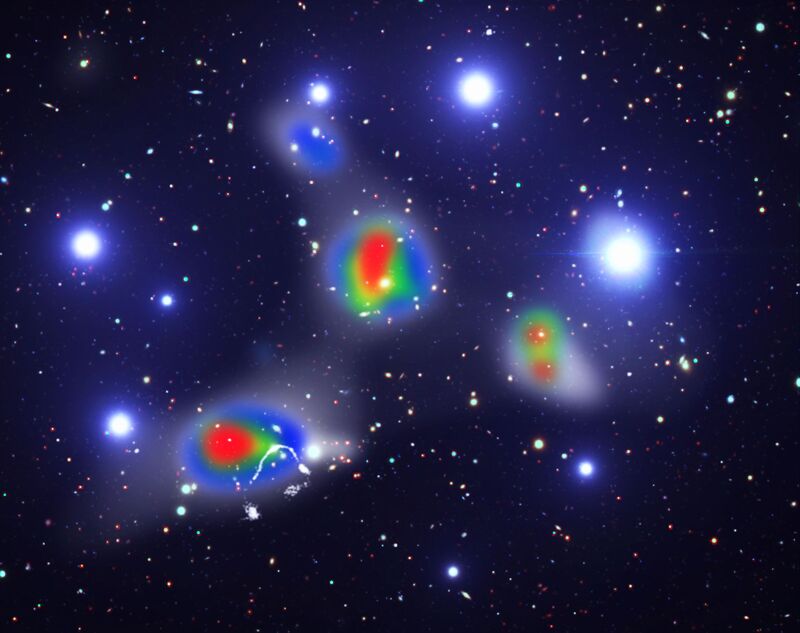A Wide Angle Tail Radio Galaxy in the COSMOS Field
Description
Color composite image showing a wide angle tail radio galaxy, CWAT-01, and its environment discovered in the COSMOS field. The 20 cm continuum emission from its radio lobes (which is mainly due to synchrotron radiation of relativistic electrons) was observed with the VLA and is shown in white (bottom left part of the image). The B (blue), V (green) and i+ (red) band images, taken with the Subaru telescope, are shown in the background. These images show light observed in optical wavelengths which comes from foreground stars and stars in distant galaxies. Some of theses galaxies belong to the host cluster of CWAT-01. The X-ray emission of the galaxy clusters is shown in grey to red color gradients. It arises from bremsstrahlung of thermal electrons in the intra-cluster medium and was taken with the XMM-Newton satellite. Wide-angle tail galaxies are a special class of radio galaxies,usually found in galaxy clusters, whose radio jets are bent into a wide "C" shape. Their morphology suggests that they strongly interact with their external environment. Such galaxies are often found in merging cluster systems. The wide angle tail galaxy CWAT-01 is part of a very complex galaxy cluster assembly consisting of at least four X-ray luminous clusters at a redshift of z=0.2. This cluster system is presumably in the process of forming a large cluster having a minimum mass of about 20 percent of the Coma cluster mass.
Color composite image showing a wide angle tail radio galaxy, CWAT-01, and its environment discovered in the COSMOS field. The SUBARU B (blue), V (green), and i+ (red) bands are displayed in the background. The diffuse X-ray emission (i.e. the wavelet reconstruction of the 0.5-2 keV band image observed with XMM-Newton) is presented by grey to red color gradients. The 1.4 GHz map (obtained using the VLA) is shown in white. The image encompasses an area of 10'x8' which corresponds to approximately (2.1x1.7) squared Mpc at the galaxy clusters' redshift of z=0.2. North is towards the top of the image and east towards left. CWAT-01 is part of a very complex galaxy cluster assembly consisting of at least four X-ray luminous clusters at the same redshift. This cluster system is presumably in the process of forming a large cluster. Using the total masses of the individual clusters obtained from the X-ray spectral analysis we estimate that the final single cluster after the individual clusters merge will have a minimum mass of about 20 percent of the Coma cluster mass. Details about this radio galaxy and cluster assembly can be found in Smolcic et al. 2006.
Creator
Legacy Astronomical Images
Rights
NRAO/AUI/NSF does not hold full copyright for this image. Contact the archivist for details.
Type
Legacy Astronomical Image
Object Name
CWAT-01
Photo Credit
Vernesa Smolcic, MPIA
Investigators
Vernesa Smolcic, MPIA
Telescope
Very Large Array (VLA)
Type of Observation
continuum
Center of Image
RA 10:0:21.100, Dec: 2:23:3.100 (J2000)
Field of View
0.166667 x 0.133333 degrees
Notes
Contact the archivist for a high resolution tif of this image.
Series
Active Galactic Nuclei Series
Unit
Radio Galaxies Unit
Citation
Legacy Astronomical Images, “A Wide Angle Tail Radio Galaxy in the COSMOS Field,” NRAO/AUI Archives, accessed June 13, 2025, https://www.nrao.edu/archives/items/show/33393.

